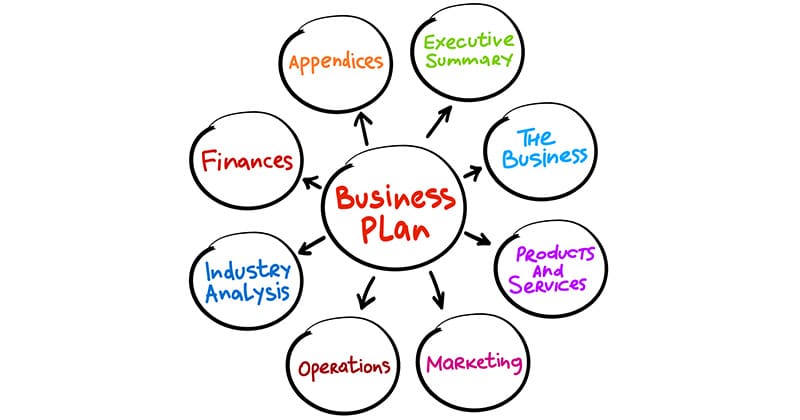Home Remodeler Marketing: 10 Strategies and Tips
Running a home or field service business requires more than skills. It needs a solid plan.
Although writing a business plan might sound like doing paperwork, it’s not. It’s your map. It shows how to turn your expertise into a profitable business.
One crucial part of these plans is a pricing strategy. What you charge reflects the value you offer customers. It also keeps your business running.
In this article, we will discuss the different business plan types and provide business plan examples to help guide you. You’ll learn about various business plan structures and get a business plan pricing sample to use.
Plus, we’ll share strategies to help you stand out, win customers, and reach your financial goals.
RELATED ARTICLE — How To Start a Home Renovation Business: Step by Step
5 Types of Business Plans for Contractors

A business plan is what guides you through running a business. It outlines your business goals and the strategy you will use to achieve them.
The type of plan you write depends on a few things. That includes the size of the business, what you hope to achieve, and who it’s for.
Here are five common types of plans you can use as a home services contractor:
- Startup Business Plan. A startup business plan launches your contracting business. It explains your idea, details your services, and identifies target customers. Your business plan helps you stand out by highlighting what makes your business unique to customers and investors.
- Feasibility Plan. A feasibility plan helps you decide whether a business idea will work. Before beginning a new service or big project, analyze the cost and market demand. Then, plan how you will address the market gap. This helps you make better decisions by examining potential challenges and opportunities.
- Internal Use Plan. This plan keeps your team on track. It’s less formal but focuses on short-term goals, budgets, and daily operations. Consider it a guide for your employees.
- Strategic Business Plan. A strategic plan looks at the big picture of your business. It shows where you want your business to be in the next few years. Many will outline how you plan to get there, too. Use this plan to explore how the business might grow, add new services, or enter different markets.
- Operational Business Plan. An operational plan focuses on day-to-day business activities. It breaks down how your business runs, including workflows, resources, and team management.
FROM ONE OF OUR PARTNERS — How To Build a Business Budget: 6 Easy Steps
Business Plan Format

You can write your plan or use a business plan template to create a professional, tailored document. But either way, it should include several key sections.
Executive Summary
The executive summary is your business plan’s most important section. It’s a quick snapshot that tells your business story in just one or two pages.
For example, consider a plumber. They might state that they have 15 years of experience in the residential industry and are keen on expanding their offerings to include smart home plumbing solutions.
Market Research
Market research helps you understand your customers and business landscape. You’ll determine who needs your services, what they want, and how to meet their needs.
For instance, a roofing contractor might research local homeowner demographics and roof replacement trends and identify underserved neighborhoods with older homes.
Products and Services
This section explains what you offer and why it matters to customers. Break down your services in detail, showing how you solve specific problems.
An HVAC contractor could describe energy-efficient installation services, maintenance packages, and 24/7 emergency repair options that set them apart from competitors.
Marketing Strategy
Your marketing strategy outlines how you’ll attract and keep customers. It also explains your channels for reaching potential clients and building your brand.
A landscaping business might outline social media marketing, local advertising, referral programs, and partnerships with home improvement stores.
Company Description
Tell the story of your business—who you are, why you started, and what makes you unique. Highlight your mission, legal structure, and core values.
An electrical contracting company might explain its commitment to sustainable energy solutions and community development.
Financial Plan
The financial plan reveals how your business will make and manage money. It should include projected income, expenses, and economic forecasts for the next 3-5 years.
A residential construction builder could show startup costs, expected revenue growth, and potential investment needs.
RELATED ARTICLE — 10 Business Expense Categories You Need To Consider
Pricing Strategy
When you’ve detailed operating costs and potential growth, you can use it to explain what you’re charging for services. Remember, your pricing section is more than just numbers. It’s a chance to show the value of your services and the professionalism of your business. A well-crafted pricing strategy can be a powerful tool for attracting and keeping customers.
If you run a painting business, you might charge different prices for the quality of paint, the type of surface, and the time of year. Anything that impacts your potential to turn a profit has an impact.
Competitive Analysis
Explain who your competitors are and how you’re different. Break down their strengths and weaknesses to show why customers should choose you.
Painters might compare their specialized commercial services, advanced techniques, and faster turnaround times.
Appendix
The appendix is where you add supporting documents and detailed information. Include licenses, certifications, thorough market research, and additional financial documents.
A plumbing business might include details about trade certifications, sample contracts, and detailed market research reports.
Management Personnel
Introduce the key people who will make your business successful. Highlight their experience, skills, and qualifications.
An HVAC company might showcase the owner’s 20 years of industry experience and key team members’ specialized technical certifications.
Permits and Licenses
List all the legal documents required to operate your business. Show that you understand and have completed all necessary legal requirements.
A roofing contractor would include licenses, insurance documents, and unique commercial or residential work permits.
FROM ONE OF OUR PARTNERS — How To Write a Business Plan: A Step-By-Step Guide
6 Tips for Writing Your Business Plan Pricing Section

When writing your business plan, the pricing section needs extra care. That’s because, without a strong pricing strategy, it’s hard to guarantee you’re going to break even. Here are some tips for writing a strong pricing section.
- Be Specific About Your Costs. Detail exactly where your money goes. Clients want to understand what they’re paying for. A plumbing contractor might show a detailed breakdown of labor costs, materials, equipment maintenance, and overhead expenses. This transparency builds trust and helps customers see the real value behind your pricing.
- Align Pricing with Your Local Market. Do market research to set the correct prices. Look at what other contractors in your area charge for similar services. You want to be competitive without selling yourself short. Pricing should reflect your expertise and quality of service.
- Highlight Your Unique Value. Pricing isn’t just about numbers—it’s about showing why you’re worth every dollar. Explain the unique benefits you bring to customers. Maybe you use premium materials, have special certifications, or offer faster service. These unique qualities justify your pricing.
- Consider Tiered Pricing Options. Offering different service levels helps you attract customers. Create packages that meet various needs and budgets. This approach lets customers choose what works best for them while giving them flexibility in pricing.
- Communicate Pricing Transparently. Have a clear plan for how you’ll discuss prices with customers. Create a standard process for giving quotes and explaining costs. Transparency prevents misunderstandings and builds customer confidence.
- Show How Pricing Fits Your Business Strategy. Your pricing should support your overall business goals.
FROM ONE OF OUR PARTNERS — What Is a Pricing Strategy? Tips & Examples
One Tool to Manage Your Business
Save time, win more jobs, and get paid faster with quick estimates, professional invoices, and payment tracking, all with Joist.